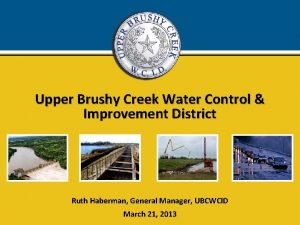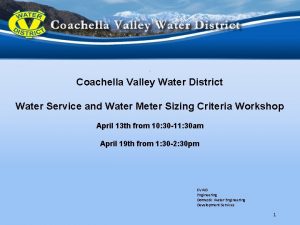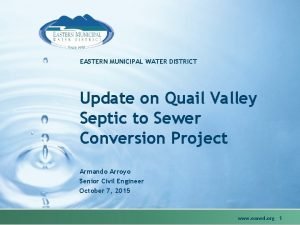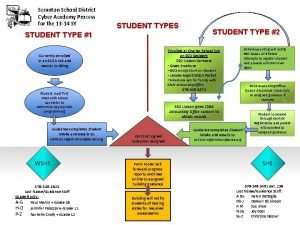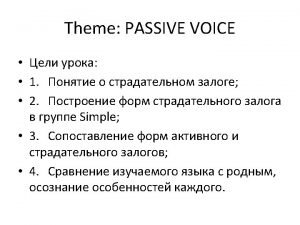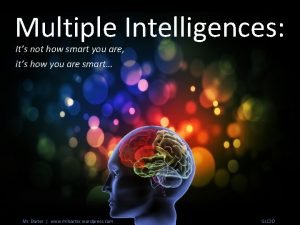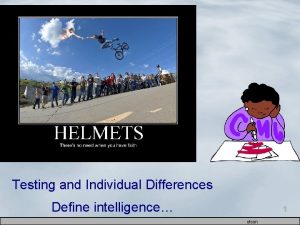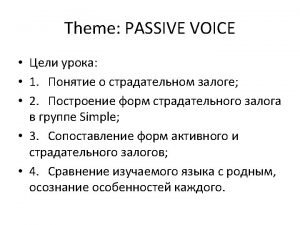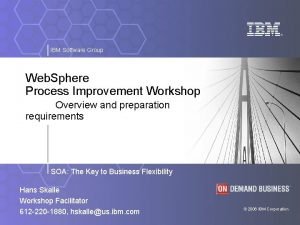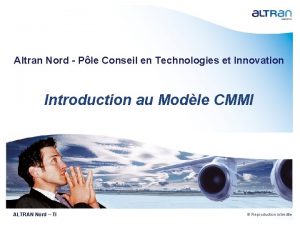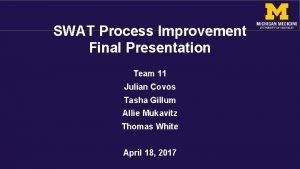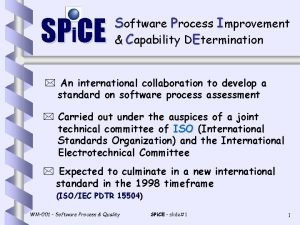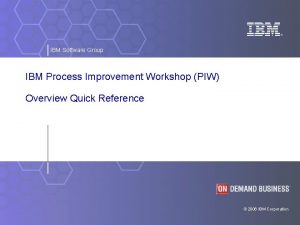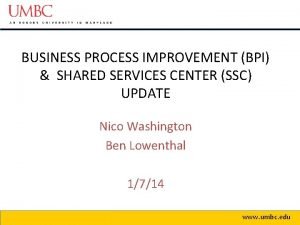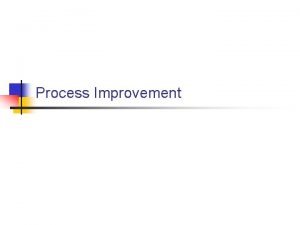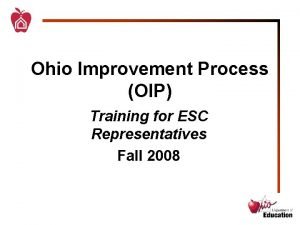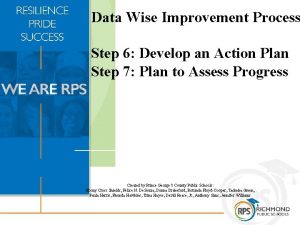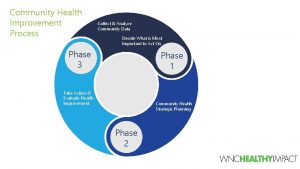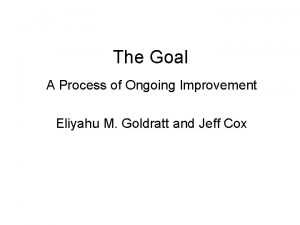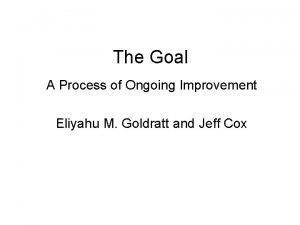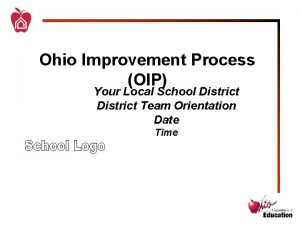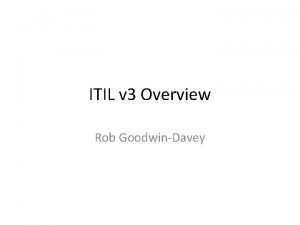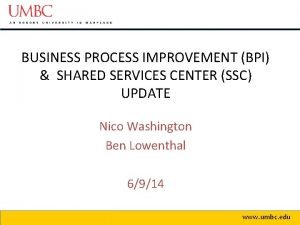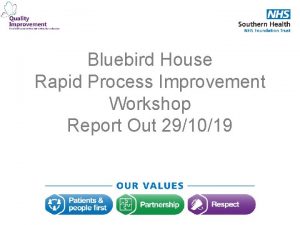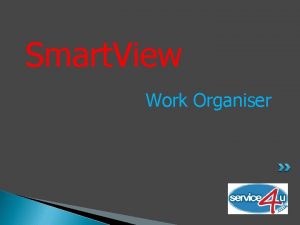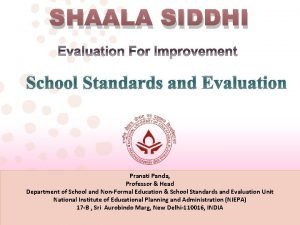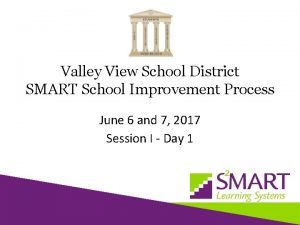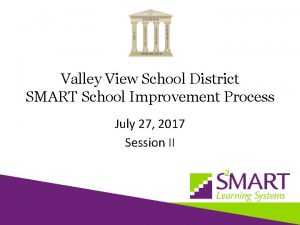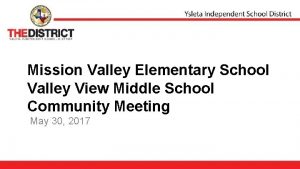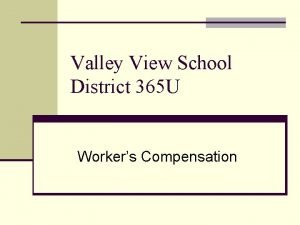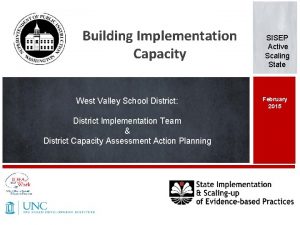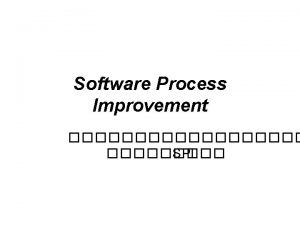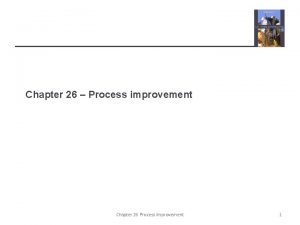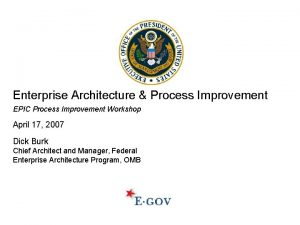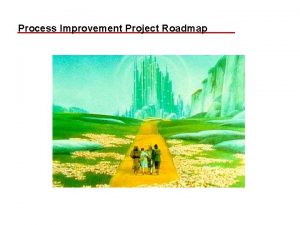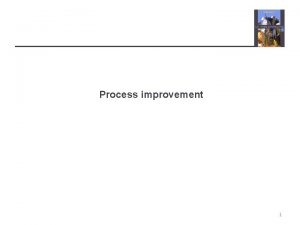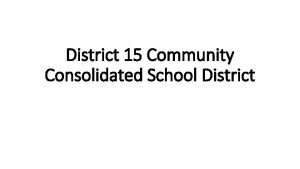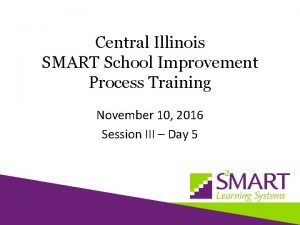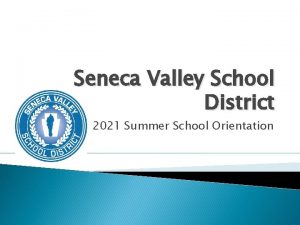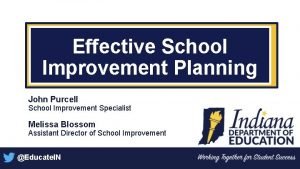Valley View School District SMART School Improvement Process









































- Slides: 41

Valley View School District SMART School Improvement Process September 21, 2017 Session III

Session III Overview ▪ Purpose: Enhance school, team and educator effectiveness by linking clearly defined school improvement goals to strategic school-wide actions ▪ Concept: Collaboration ▪ Bridge: Action © 2017 SMART Learning Systems, LLC

Session III Overview ▪ Essential Question: How does a collaborative culture impact educator effectiveness in leading goal-directed actions? ▪ Outcomes ▪ Agenda Overview © 2017 SMART Learning Systems, LLC

Connecting Sessions II and III Team Reflection Think about the process(es) you used to share your school improvement work with your BITs and staff between Sessions II and III. Discuss your perceptions of how the information was received. Provide at least one example of each of the following reactions: § Aha! § Oh no! § Wondering § Surprise © 2017 SMART Learning Systems, LLC

The Data – Logic Chain Logic Logic © 2017 SMART Learning Systems, LLC Data LEARNING and ACTION are embedded in the process.

SMART School Improvement Process Step #5 Analyze and refocus Step #4 Between Steps Develop action plans Step #3 Step #2 Create school SMART goal Step #1 Isolate need © 2017 SMART Learning Systems, LLC Implement plans Between Steps Select strategies Explore professional learning options Between Steps Investigate effective practices Between Steps Begin again! Gather and analyze data

SMART Goal Tree School Results Goal © 2017 SMART Learning Systems, LLC School Indicators School Measures School Targets

Bill’s Goal-Focused Plan Method VISION: Have a high quality of life © 2017 SMART Learning Systems, LLC • Exercise Classes • Healthy Eating • Support Group

SMART School Improvement Process Step #5 Analyze and refocus Step #4 Between Steps Develop action plans Step #3 Step #2 Create school SMART goal Step #1 Isolate need © 2017 SMART Learning Systems, LLC Implement plans Between Steps Select strategies Explore professional learning options Between Steps Investigate effective practices Between Steps Begin again! Gather and analyze data

Valley View Goal Tree School SMART Goal Tree VISION: Ensure academic and social emotional success for ALL students in VVSD © 2017 SMART Learning Systems, LLC Strategies* § Teacher Clarity/ Formative Assessment § Learning Environment * From Hattie’s Research on Visible Learning

Indicators Results Goal By May, 2018 the number of students meeting college & career readiness levels (as measured by PARCC) will increase by 6%. Vocabulary: determine the meaning of words and phrases as they are used in a text (RL/RI. 4) Informational Text: Writing: stating claims and supporting with evidence (W. 1) © 2017 SMART Learning Systems, LLC

Indicators Vocabulary: determine the meaning of words and phrases as they are used in a text Informational Text: Writing: stating claims and supporting with evidence Universal Strategy: Formative Assessment Targeted Focus Area in the Scope & Sequence Clarity linked to rigorous learning tasks Rationale/ Evidence/ Baseline Professional Learning Formative Indicators of Success § Unwrapping § Teacher practice & DOK walkthrough rubric § 5 E voice levels § Student voice evidence § Designing rubric of challenge § Teacher rigorous § Assessment Practice tasks outcomes aligned § Student § Formative Outcomes to certain assessment standards strategies © 2017 SMART Learning Systems, LLC Resource Needs § BIT planning § CFA support § $ for staff work in designing rubrics

INDICATORS Vocabulary: determine the meaning of words and phrases as they are used in a text Informational Text: Writing: stating claims and supporting with evidence Universal Strategy: Learning Environment Targeted Focus Area Rationale/ Evidence/ Baseline Teacher Language § 5 E voice evidence (Targeted Domains) § Teacher Practice § Student Outcomes © 2017 SMART Learning Systems, LLC Professional Learning Formative Indicators of Success § Student voice (SSIT created § Power of survey) our words § RC Assessment book study Rubric aligned § Responsive to Teacher Classroom Language PD (Targeted Questions) Resource Needs § Power of Our Words or related books § Job Embedded PD

High Leverage School-Wide Strategies © 2014 SMART Learning Systems, LLC

Step#4: Develop Action Plans

SMART School Improvement Process Step #5 Analyze and refocus Step #4 Between Steps Develop action plans Step #3 Step #2 Create school SMART goal Step #1 Isolate need © 2017 SMART Learning Systems, LLC Implement plans Between Steps Select strategies Explore professional learning options Between Steps Investigate effective practices Between Steps Begin again! Gather and analyze data

Between Steps 2 & 3; Step #3; Between Steps 3 & 4; and Step #4 Investigate Effective Strategies. Consider District-wide © 2017 SMART Learning Systems, LLC Select Strategies Explore Professional Learning Options Develop Action Plans

Critical Attributes of a District-wide or School-wide Strategy ▪ Focus on high-leverage actions that are known to yield positive results across all content areas, grades and subgroups ▪ Incorporate curricular, instructional and assessment practices that consider rigor, depth of content knowledge, student engagement, teacher clarity, higher order thinking skills and high expectations ▪ Incorporate teacher professional learning processes and structures with ongoing professional growth opportunities © 2017 SMART Learning Systems, LLC

Essential Question: Which district-wide strategies do we need to consider? § Clearly defined Learning Targets & Success Criteria linked to standards § Student understanding of target and success criteria § Assessment capable learners § Directly linked to success criteria § Based on learner readiness § Feeds learning forward toward mastery © 2017 SMART Learning Systems, LLC Teacher Clarity Formative Assessment Feedback Responsive Learning Environment § Clarity linked to rigorous learning tasks § Learning progressions § Evidence of student learning § Drive instructional decisions § Safe learning environment § Positive relationships

High Leverage School-Wide Strategies © 2017 SMART Learning Systems, LLC

TEAM AND CLASSROOM PRACTICES Low Leverage High Leverage SCHOOL-WIDE STRATEGIES © 2017 SMART Learning Systems, LLC

School-wide: Breakthrough DESIRED GAP BASELINE © 2017 SMART Learning Systems, LLC Grade/Dept. Level: Incremental

Discussion ▪ What is your school currently doing that is consistent with the district’s non-negotiable strategies? ▪ Which of the district non-negotiables have the benefit of existing staff expertise but are not yet widely adopted on a school-wide basis? ▪ How might existing expertise be leveraged? ▪ Are there current classroom or team practices that should be abandoned in favor of these strategies? ▪ Where is your school on the scope and sequence criteria for each district non-negotiable strategy? © 2017 SMART Learning Systems, LLC

Essential Question: What other best practices might you want to consider for school-wide implementation? Other Remember: Less is More © 2017 SMART Learning Systems, LLC

Once we have selected strategies, how do we create a SMART Action Plan? © 2017 SMART Learning Systems, LLC

Pro fess Lea ional rnin g Rationale/ Evidence Action Plan e c r u o s Re s d e Ne © 2017 SMART Learning Systems, LLC For Ind mati v i c ato e of Su r cce s ss For each strategy. . .

SMART Action Plan Strategy Rationale/ Evidence Professional Learning Formative Indicators of Success Resource Needs (“Title” Connections). © 2017 SMART Learning Systems, LLC

SMART Action Plan Strategy Rationale/ Evidence Common Formative Assessment Feedback: Student-Teacher Relationships Other: Student Engagement/ Responsibility for their own Learning © 2017 SMART Learning Systems, LLC Professional Learning Formative Indicators of Success Resource Needs (“Title” Connections).

SMART Action Plan Components Strategy Professional Learning Rationale/ Evidence Formative Indicators of Success Resource Needs (“Title” Connections) What strategy(ies) will we implement school wide to achieve the School SMART Goal? What professional learning design(s) will we use to assure the strategies are implemented with fidelity? These are the priorities identified in SMART Process Step #3: Select Strategies. These are the decisions made between SMART Process Steps 3 & 4: Explore Professional Learning Options. What is the evidence that this strategy is a priority? What additional evidence may be needed to verify this as a priority? What will successful implementation with fidelity look like? How will progress be monitored? How will successes and opportunities for improvement be reported? What resources will be needed to implement our plans with fidelity? What resources can be repurposed? What budgetary material and time challenges need to be considered? This will be identified and used in Step #3: Select Strategies. This will be identified in Step #4: identified in Step Develop Action Plans. #4: Develop Action Plans. © 2017 SMART Learning Systems, LLC

Action Plan (Scope & Sequence LINK) © 2017 SMART Learning Systems, LLC

Energy Break © 2017 SMART Learning Systems, LLC

Between Steps 4 and 5: Implement Plans

SMART School Improvement Process Step #5 Analyze and refocus Step #4 Between Steps Develop action plans Step #3 Step #2 Create school SMART goal Step #1 Isolate need © 2017 SMART Learning Systems, LLC Implement plans Between Steps Select strategies Explore professional learning options Between Steps Investigate effective practices Between Steps Begin again! Gather and analyze data

Blueprint for Implementation © 2017 SMART Learning Systems, LLC

Grade Level SMART Goal Tree in support of the School SMART Goal Indicators Targets Measures # of students By (1 year), ___% of all 5 th grade students will be proficient or above in (school GAN) Tested standard in content area aligned with school GAN indicators Common Formative Assessment Common Assessment Blue Green Yellow Baseline Red Blue Green Yellow Progress Check Red Blue Green Yellow Red © 2017 SMART Learning Systems, LLC Results Target (# of students)

SMART Professional Learning Planning SMART Results Goal: copied from the SMART Goal Tree Diagram Strategies associated with this goal: teacher clarity/formative assessment, learning environment © 2017 SMART Learning Systems, LLC Back to Page 1 Click HERE for the SMART Professional Learning Planning template

Expectations for Between Sessions III and IV ▪ Share your action plan with your BIT ▪ Research timelines for the implementation of specific strategies, including when and how professional learning will occur ▪ Assist Grade Level/Department Impact Teams to create a SMART Goal Tree for their grade level or department ▪ Connect grade level and department goals to your school goal and strategies © 2017 SMART Learning Systems, LLC

November Session § Two half-day sessions on November 16 § November’s session will focus on: – Implementing your plans (Between Steps 4 and 5) – Measuring the implementation and impact of your actions – Monitoring your progress – Making needed adjustments © 2017 SMART Learning Systems, LLC

Journal Entries ▪ What did I learn today that affirmed my prior knowledge and skills? ▪ What did I learn today that furthered my prior knowledge and skills? ▪ What did I learn today that challenged my thinking and raised questions in my mind? ▪ What did I learn today that excited me most? © 2017 SMART Learning Systems, LLC

Exit Tickets – As a team, identify patterns of responses from each of the four Journal entries to complete your team’s exit ticket. What did I learn today that affirmed my prior knowledge and skills? What did I learn today that furthered my prior knowledge and skills? What did I learn today that challenged my thinking and raised questions in my mind? What did I learn today that excited me most? © 2017 SMART Learning Systems, LLC

Thank you SMART People! smartlearningsystems. com Building capacity for student-focused, goal directed learning © 2017 SMART Learning Systems, LLC
 Brushy creek water
Brushy creek water Las gallinas valley sanitary district
Las gallinas valley sanitary district Coachella valley water line repair
Coachella valley water line repair Irwd.com
Irwd.com Quail valley utility district
Quail valley utility district Crescenta valley high school summer school
Crescenta valley high school summer school Lodi unified school district summer school
Lodi unified school district summer school Indian school, al wadi al kabir colors
Indian school, al wadi al kabir colors Scranton school district cyber school
Scranton school district cyber school Street smarts vs book smarts
Street smarts vs book smarts One smart man he felt smart
One smart man he felt smart It's not how smart you are it's how you are smart meaning
It's not how smart you are it's how you are smart meaning Future smart smart shopping answers
Future smart smart shopping answers It's not how smart you are it's how you are smart
It's not how smart you are it's how you are smart What is the next letter? a z b y c x d
What is the next letter? a z b y c x d Street smart vs book smart quotes
Street smart vs book smart quotes One smart man he felt smart
One smart man he felt smart Valley view tigers
Valley view tigers Ibm checkpoint goals examples
Ibm checkpoint goals examples Altran nord
Altran nord Swat presentation
Swat presentation Spi in software engineering
Spi in software engineering 7 step improvement process
7 step improvement process Ibm process improvement
Ibm process improvement Shared services process improvement
Shared services process improvement Test process improvement
Test process improvement Community health improvement process
Community health improvement process Rpiw process
Rpiw process Oip training
Oip training Data wise meeting norms
Data wise meeting norms Community health improvement process
Community health improvement process The goal: a process of ongoing improvement
The goal: a process of ongoing improvement The goal boy scout hike
The goal boy scout hike Rapid process improvement methodology
Rapid process improvement methodology Ohio improvement process
Ohio improvement process Step 1 in 7 step improvement process
Step 1 in 7 step improvement process Shared services process improvement
Shared services process improvement Rapid process improvement workshop
Rapid process improvement workshop Smart view update
Smart view update Smart view indicator
Smart view indicator School evaluation dashboard sample
School evaluation dashboard sample Swot analysis for school improvement plan
Swot analysis for school improvement plan
